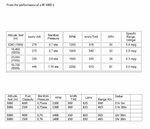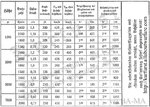Navigation
Install the app
How to install the app on iOS
Follow along with the video below to see how to install our site as a web app on your home screen.
Note: This feature may not be available in some browsers.
More options
You are using an out of date browser. It may not display this or other websites correctly.
You should upgrade or use an alternative browser.
You should upgrade or use an alternative browser.
DB601A Cruising Fuel Consumption
- Thread starter krieghund
- Start date
Ad: This forum contains affiliate links to products on Amazon and eBay. More information in Terms and rules
More options
Who Replied?wells
Airman
Failing any manufacturer's data, it can be calculated to a reasonable degree of accuracy.
0.08 g / L at 1.0 atm at 288 deg K ( 15 C sea level )
stoichiometric ratio of 15 for octane ( C8H18 ) = auto lean mixture
Displacement 33.9 L
Multiply by Displacement * RPM * 0.03 for kg per hr
For L per hr, divide by density of = 0.717 kg / L ( 6 lbs / US Gal, 7.2 lbs / Imp Gal )
So, 1 atm at 2000 RPM would give 166 kg / h or 221 L / h
The calculations can be compared to known data given in pilot's notes for various engines, to give some idea of accuracy. Here's some examples,
I have for the DB605 from a British test of a 109G-2 Trop
54.25 Imp Gal / hr at 1.0 ata and 2100 RPM at 18700 ft
This is equivalent to 246 L/hr. At sea level in standard atmosphere, we have to reduce this figure to 214 L / hr to account for the higher ambient temperature for a given pressure ( air density is lower, see ideal gas law PV = nRT )
The above calculation for the DB605 in this case ( 35.7 L ) gives 180 kg / hr or 251 L / hr
This was probably a bad example, since I assumed 1 atm = 1 ata
Using the proper conversion factor should improve the accuracy, which is left as an exercise for the reader. hehehe
0.08 g / L at 1.0 atm at 288 deg K ( 15 C sea level )
stoichiometric ratio of 15 for octane ( C8H18 ) = auto lean mixture
Displacement 33.9 L
Multiply by Displacement * RPM * 0.03 for kg per hr
For L per hr, divide by density of = 0.717 kg / L ( 6 lbs / US Gal, 7.2 lbs / Imp Gal )
So, 1 atm at 2000 RPM would give 166 kg / h or 221 L / h
The calculations can be compared to known data given in pilot's notes for various engines, to give some idea of accuracy. Here's some examples,
I have for the DB605 from a British test of a 109G-2 Trop
54.25 Imp Gal / hr at 1.0 ata and 2100 RPM at 18700 ft
This is equivalent to 246 L/hr. At sea level in standard atmosphere, we have to reduce this figure to 214 L / hr to account for the higher ambient temperature for a given pressure ( air density is lower, see ideal gas law PV = nRT )
The above calculation for the DB605 in this case ( 35.7 L ) gives 180 kg / hr or 251 L / hr
This was probably a bad example, since I assumed 1 atm = 1 ata
Using the proper conversion factor should improve the accuracy, which is left as an exercise for the reader. hehehe
davebender
1st Lieutenant
A while back Kurfurst presented some historical DB605 fuel consumption data. I believe it was in the discussion on best aircraft engines.
Shortround6
Major General
Does anyone have DB601A Cruising Fuel Consumption figures starting at ata 1,0 and below to about ata 0,76/0,75?
I'm trying to work up a fuel consumption table for the DB601A series.
Thanks in advance
I don't have that information but at low power outputs the fuel consumption care vary considerably.
Most people found that using low RPM and high boost (for the rpm) gave them the best fuel consumption IF the engine/propeller controls would allow it.
For instance (if you are not already aware of it) there is a chart for the Merlin 45/46 that shows speed at altitude for various rpm and boost settings.
I would assume (I Know
At 2000 ft and 200 IAS at -2.5lb and 2650 rpm the engine would use 35 gallons an hour but at -.5lbs and 1800rpm the engine used 31 gallons an hour.
At 2000 ft and 230 IAS at +.5lbs and 2650rpm the engine used 40 g/h but at +2.75lb and 1800rpm it used 35 g/h.
I don't know if the German controls (throttle and propeller pitch) allowed for such settings.
- Thread starter
- #5
wells
Airman
Ugh,
that top chart is a disaster, especially the last row at 6000 m
445 IAS is 610 TAS ( 330 knots )TAS, not 515 ( I highly doubt 67 km/h instrument error ). Even then, I get 4.1 mpg, not 5.0.
The other 3 rows look reasonable, except the IAS in the first row should be right around 300. Although, I suppose there could be 25 km/h instrument error? Seems like a lot
that top chart is a disaster, especially the last row at 6000 m
445 IAS is 610 TAS ( 330 knots )TAS, not 515 ( I highly doubt 67 km/h instrument error ). Even then, I get 4.1 mpg, not 5.0.
The other 3 rows look reasonable, except the IAS in the first row should be right around 300. Although, I suppose there could be 25 km/h instrument error? Seems like a lot
- Thread starter
- #7
Ugh,
that top chart is a disaster, especially the last row at 6000 m
445 IAS is 610 TAS ( 330 knots )TAS, not 515 ( I highly doubt 67 km/h instrument error ). Even then, I get 4.1 mpg, not 5.0.
The other 3 rows look reasonable, except the IAS in the first row should be right around 300. Although, I suppose there could be 25 km/h instrument error? Seems like a lot
Yes that is my problem and why I am looking for OEM data. I think the airspeed at 6km should be about 495km not 515 as referenced in this table from an Airfix book on building the Bf109E.
Attachments
davebender
1st Lieutenant
How are your German language skills?
Kurfurst - Your resource on Messerschmitt Bf 109 performance
The Kurfurst site has a bunch of source documents for the Me-109 fighter plus DB601 and DB605 engines. As one would expect most of these documents are written in German.
Kurfurst - Your resource on Messerschmitt Bf 109 performance
The Kurfurst site has a bunch of source documents for the Me-109 fighter plus DB601 and DB605 engines. As one would expect most of these documents are written in German.
Tzaw1
Airman 1st Class
- Thread starter
- #10
- Thread starter
- #11
I have done some math on the range table and found something interesting. In comparing the fuel usage without an external tank every altitude throttle/speed range consumes about 300 liters for the distance given which leaves 100 liters left for start-up, taxi and take-off with I guess reserves and a combat allowance.
When calculating a table of fuel consumption per altitude with different throttle settings one must also include the fuel used to climb to that altitude and add the distanced climbed to the total distance traveled but usually let-down and and landing are not included in the distances.
Because every altitude has the same amount of fuel remaining I have to assume that fuel to climb is not included.
When calculating a table of fuel consumption per altitude with different throttle settings one must also include the fuel used to climb to that altitude and add the distanced climbed to the total distance traveled but usually let-down and and landing are not included in the distances.
Because every altitude has the same amount of fuel remaining I have to assume that fuel to climb is not included.
Tzaw1
Airman 1st Class
- Thread starter
- #13
Users who are viewing this thread
Total: 1 (members: 0, guests: 1)



